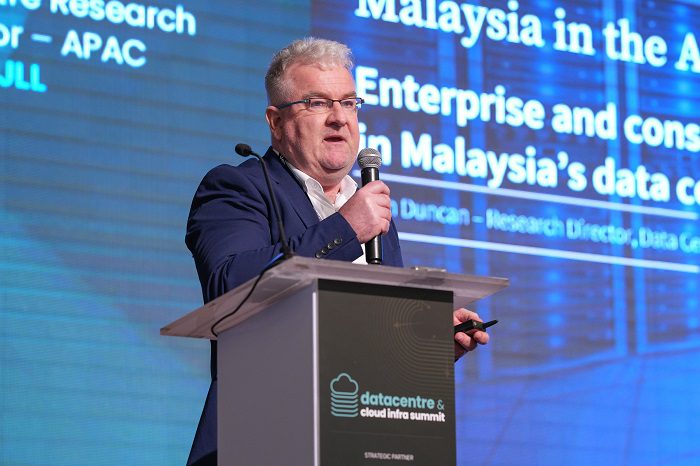

Growth in Malaysia’s data centre and cloud ecosystems is influenced by factors such as internet behaviour, application ecosystems, and energy generation, as discussed by industry representatives at the 2nd Datacentre & Cloud Infrastructure Summit (DCCI) held in Kuala Lumpur last month.
According to Glen Duncan (pic above), JLL APAC Data centre Research Director, understanding these factors is crucial, and he referred to Malaysia as an emerging market in the data centre space within the APAC region.
Research by IDC noted that Malaysian public cloud services revenue reached approximately US$600 million (RM2.80 billion) in 2021, with forecasts predicting it will grow to around US$1.8 billion (RM8.37 billion) by 2026. To date, the country hosts 41 enterprise data centres, backed by investments from major tech companies like NTT, Microsoft and Amazon Web Services (AWS), amounting to billions of dollars.
Duncan explained that Malaysia’s internet behaviour is primarily driven by extensive mobile network coverage and the rising adoption of mobile devices in the country. The usage of various applications such as social media platforms, e-commerce, and e-wallets has contributed to a robust Western application ecosystem in Malaysia.
Connectivity, edge computing, and hybrid cloud
The country’s shift towards hybrid multi-cloud environments signifies significant growth opportunities. Jeremy Deutsch, President of Equinix Asia Pacific, said the hybrid multi-cloud architecture is a global trend, and organisations across the APAC region are adopting it. Consequently, Malaysia’s legacy and traditional companies are expected to follow suit for their future operations.
Connectivity plays a crucial role in this transition. Deutsch emphasised, “How do I make sure that everything is seamlessly able to connect to each other at high speeds, low cost, and with full security? That’s a big thing to solve.”
Edge computing and modular data centres are also emerging as critical drivers for meeting the increasing demand for data processing. “Because of the cloud and mobile devices, we’re going to see more and more of the data centre push to the edge,” Duncan noted.
Where data centres should be located is also becoming increasingly important for certain industries. “Data gravity is a consideration for industries such as manufacturing where data needs to be close to the source,” said Dominic Wong, Chief Architect for ASEAN at Hitachi Vantara. Cost management, particularly in data uploading and downloading, is another challenge in data management.
Capitalising on these kinds of edge markets is an opportunity Malaysian companies should leverage, as well as exploring the spill-over effect from Singapore due to its govt moratorium on data centre construction in 2019. Since then, Johor has become the centre of data centre investments, with companies like Equinix, AirTrunk, and Yondr Group establishing facilities in the state, which is expected to attract around RM15 billion worth of data centre investments over the next decade.
Don’t rely exclusively on foreign input
Deutsch commended the Malaysian government’s approach towards digital transformation, saying, “One of the best things I have seen the Malaysian government do is to appreciate that it’s an ecosystem. It’s not just one company doing digital transformation on its own.”
However, to maximise growth in the data centre industry in Malaysia, innovation, collaboration, and government support are necessary. Duncan warned against relying exclusively on foreign investments and stressed the need to develop a local, homegrown application ecosystem catering to Malaysia’s unique market needs.
This should also take into account preparing for future trends in data centres. “The biggest challenge that I’m seeing is picking the right architecture upfront. Have a really good think about how your architecture is going to look in six to 12 months time and make sure you’re taking into consideration where you are connecting to,” Duncan added.
In the meantime, while issues like data sovereignty and data compliance have fallen slightly off the radar, Jenny Goh, Hitachi Vantara Malaysia Enterprise Sales Director, pointed out that they are still important considerations, especially for sectors like banking.
Nevertheless, as for what the future brings, she highlighted that many Malaysian companies often adopt a wait-and-see approach. “Let somebody else take the lead, see what happens, and only after that follow,” she said. “That is the behaviour in Malaysia.”



Leave a Comment